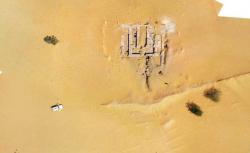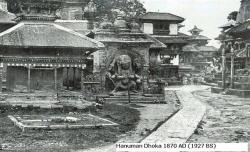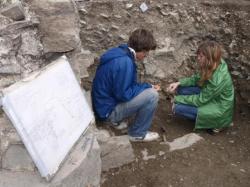INSTITUT SUPERIEUR D'ANTHROPOLOGIE
INSTITUTE OF ANTHROPOLOGY
ONLINE COURSES / COURS A DISTANCE
SPRING SESSION : APRIL 2013
REGISTER NOW
SOUDAN –  Sonijat - The largest known royal palace of Kush (namely 5000 square meters) has been found according to Polish news reports. The excavation campaign was led by Dr Bogdan Zurawski; the team had already found a temple at the site in 1998. The discovery was made on the rightside bank of the Nile between the third and fourth cataracts in Sonijat, in the Sudanese region of Tergis. The name of the region Tergis derives from the ancient city Tergedus, mentioned in the description of Nero’s expedition of 60 AD (see Pliny the Elder, “Natural History”, book 6). Zurawski suggests that Tergis / Tergedus is to be equated with the city Trgb which is known from the expedition to Nubia by Pharaoh Psamtek II in 593 BC, and with an unnamed location (in the “Krtn” nome) mentioned in the 5th c. BC stela of Kushite king Irike Amannote. These texts (or one of them?) mention a ruined royal palace, so the present discovey of such a royal palace, combined with the geography (located halfway between Napata and Kawa), now proves these equations.
Sonijat - The largest known royal palace of Kush (namely 5000 square meters) has been found according to Polish news reports. The excavation campaign was led by Dr Bogdan Zurawski; the team had already found a temple at the site in 1998. The discovery was made on the rightside bank of the Nile between the third and fourth cataracts in Sonijat, in the Sudanese region of Tergis. The name of the region Tergis derives from the ancient city Tergedus, mentioned in the description of Nero’s expedition of 60 AD (see Pliny the Elder, “Natural History”, book 6). Zurawski suggests that Tergis / Tergedus is to be equated with the city Trgb which is known from the expedition to Nubia by Pharaoh Psamtek II in 593 BC, and with an unnamed location (in the “Krtn” nome) mentioned in the 5th c. BC stela of Kushite king Irike Amannote. These texts (or one of them?) mention a ruined royal palace, so the present discovey of such a royal palace, combined with the geography (located halfway between Napata and Kawa), now proves these equations.
http://www.archaiologia.gr/en/blog/2013/04/05/kushite-royal-palace-found-in-sonijat/
FRANCE – Strasbourg - Les fouilles archéologiques continuent sous la place Saint-Thomas. Une pelleteuse était à pied d'œuvre jeudi matin pour le lancement d'une seconde phase de travaux. Elle durera jusqu'à début mai, selon Eric Boës, de l'Inrap (Institut national de recherches archéologiques préventives). « Sur la première phase, nous avons mis en évidence un cimetière qui remonte à l'époque carolingienne et qui n'était pas connu jusqu'ici », rapporte-t-il. Une trentaine de squelettes ont ainsi été mis au jour. « En dessous du cimetière, poursuit-il, nous avons trouvé des traces de la ville carolingienne, ce qui montre que la zone d'habitation a été abandonnée et transformée en zone funéraire, et encore en dessous, aux alentours de 2 m de profondeur, des vestiges de la ville romaine. » La deuxième phase de fouilles va concerner trois fosses dans lesquelles doivent être plantés les arbres d'ornement de la place réaménagée. Les archéologues présument qu'ils y trouveront de nouveaux vestiges funéraires.
http://www.20minutes.fr/ledirect/1131785/cimetiere-sous-bitume
NEPAL –  Kathmandu - A government team began the opening of the Bhandarkhal treasure trove of the Hanumandhoka in the capital on Thursday. Among the two treasures opened today, the first one was empty and in ruins, while the second one had 15 iron and wooden boxes and seven shelves, said Director General Dahal. Similarly, other items discovered in the treasure were 48 silver bricks of 14 cm and 88 sets of silver-made items. Also, there were 15 big padlocks and some silver urns. All items found in the boxes and shelves are yet to be identified. According to the Director General, all items found in the treasure would be enlisted with details and made public in the presence of the committee members. Currently, the valuables are sealed and kept safe at the Shardul Jung Company of Nepal Army.
Kathmandu - A government team began the opening of the Bhandarkhal treasure trove of the Hanumandhoka in the capital on Thursday. Among the two treasures opened today, the first one was empty and in ruins, while the second one had 15 iron and wooden boxes and seven shelves, said Director General Dahal. Similarly, other items discovered in the treasure were 48 silver bricks of 14 cm and 88 sets of silver-made items. Also, there were 15 big padlocks and some silver urns. All items found in the boxes and shelves are yet to be identified. According to the Director General, all items found in the treasure would be enlisted with details and made public in the presence of the committee members. Currently, the valuables are sealed and kept safe at the Shardul Jung Company of Nepal Army.
http://www.myrepublica.com/portal/index.php?action=news_details&news_id=52620
CHINE – Xingzi - Archaeologists in East China's Jiangxi Province on Thursday announced that they have discovered rare mural paintings with vibrant colors in a 600-year-old tomb. The tomb, dating back to the Ming Dynasty (1368-1644), was unearthed at the site of a parking lot being built in Xingzi County, the Archaeology Institute of Xingzi County said. The wall paintings feature peonies, lotuses, chrysanthemums and sticks of bamboo with red, black, blue and yellow hues, and show a strong religious influence, the institute said. The tomb has not been damaged by thieves or vandals, but most of the murals are in poor condition, except for some well-preserved paintings covering 0.5 square meters on the eastern wall. Tombs with murals are common in northern China but very rare in the south. This is the first time that tomb murals created during the Ming Dynasty have been discovered in Jiangxi, according to experts with the institute. Archaeologists said there should be a cluster of tombs in the area, adding that they will continue their excavation efforts and try to identify the owners of tombs. (Xinhua-ANI)
http://www.newstrackindia.com/newsdetails/2013/04/04/176-Ancient-tomb-with-murals-discovered-in-East-China.html
IRLANDE –  Trim - Archaeologists are hoping to find an ancestor of Richard III – in a patch of waste ground in Trim, Co Meath, just behind the local supermarket. Beneath this four-acre rectangle of scrubby grass, bordered by a housing estate, lie the foundations of a 13th-century Dominican blackfriary, and a team of have been excavating the site, which contains many skeletons. They hope that one of these may be skeleton of sir Geoffrey de Geneville, a French nobleman who founded the friary. Okay, he wasn’t a monarch, but he was well in with both king Henry III and his successor, king Edward I, and was appointed lord of Trim in 1252 and justiciar of Ireland in 1273. He and his wife, Maud de Lacy, the granddaughter of Walter de Lacy, lived at nearby Trim castle and were quite the power couple around medieval Meath. After Maud’s death in 1304, de Geneville retired to the friary, and is believed to have been buried there. The original Dominican friary was an impressive structure, built with Purbeck limestone, a beautiful, shell-flecked marble imported from Dorset. No expense was spared in choosing building materials, but it was reckoned to be worth it – from the time of Hugh de Lacy, who became lord of Meath during the Norman Invasion, up until Henry VIII dissolved the monasteries, Trim was a political, religious and economic power base, encompassing Meath, Westmeath and parts of Louth. When Henry’s daughter Elizabeth I was setting up Trinity College, she had a choice of two deserted monasteries to choose from: the Dominican friary at Trim or the Augustinian priory at College Green in Dublin. “So the blackfriary could have been Trinity College, and the course of Irish history could have been a lot different,” says Mandal. Richard III’s great-great-great- great-great-great-great-grandfather, Geoffrey de Geneville, lord of Vaucoulours in Champagne, was a French noblemen who went to England in search of greater fortune following the marriage of Henry III to Eleanor of Provence. He was one of the “Savoyards” in the service of Henry III, and became a close confidant of the king. An arranged marriage to Maud de Lacy, the wealthy granddaughter of Walter de Lacy, former lord of Meath, saw Geoffrey became lord of Ludlow in Wales and lord of Trim in 1252. The couple had “liberty and free custom” of Meath and jointly ruled the region, taking Trim Castle as their main residence. Geoffrey accompanied prince Edward, the future king Edward I, on crusade, thus securing his trusted position in the royal court. The couple had three children, Geoffrey, Piers and Joan, all of whom died during their lifetime. After Maud’s death, Geoffrey took holy orders and lived out his days at the Dominican friary he founded.
Trim - Archaeologists are hoping to find an ancestor of Richard III – in a patch of waste ground in Trim, Co Meath, just behind the local supermarket. Beneath this four-acre rectangle of scrubby grass, bordered by a housing estate, lie the foundations of a 13th-century Dominican blackfriary, and a team of have been excavating the site, which contains many skeletons. They hope that one of these may be skeleton of sir Geoffrey de Geneville, a French nobleman who founded the friary. Okay, he wasn’t a monarch, but he was well in with both king Henry III and his successor, king Edward I, and was appointed lord of Trim in 1252 and justiciar of Ireland in 1273. He and his wife, Maud de Lacy, the granddaughter of Walter de Lacy, lived at nearby Trim castle and were quite the power couple around medieval Meath. After Maud’s death in 1304, de Geneville retired to the friary, and is believed to have been buried there. The original Dominican friary was an impressive structure, built with Purbeck limestone, a beautiful, shell-flecked marble imported from Dorset. No expense was spared in choosing building materials, but it was reckoned to be worth it – from the time of Hugh de Lacy, who became lord of Meath during the Norman Invasion, up until Henry VIII dissolved the monasteries, Trim was a political, religious and economic power base, encompassing Meath, Westmeath and parts of Louth. When Henry’s daughter Elizabeth I was setting up Trinity College, she had a choice of two deserted monasteries to choose from: the Dominican friary at Trim or the Augustinian priory at College Green in Dublin. “So the blackfriary could have been Trinity College, and the course of Irish history could have been a lot different,” says Mandal. Richard III’s great-great-great- great-great-great-great-grandfather, Geoffrey de Geneville, lord of Vaucoulours in Champagne, was a French noblemen who went to England in search of greater fortune following the marriage of Henry III to Eleanor of Provence. He was one of the “Savoyards” in the service of Henry III, and became a close confidant of the king. An arranged marriage to Maud de Lacy, the wealthy granddaughter of Walter de Lacy, former lord of Meath, saw Geoffrey became lord of Ludlow in Wales and lord of Trim in 1252. The couple had “liberty and free custom” of Meath and jointly ruled the region, taking Trim Castle as their main residence. Geoffrey accompanied prince Edward, the future king Edward I, on crusade, thus securing his trusted position in the royal court. The couple had three children, Geoffrey, Piers and Joan, all of whom died during their lifetime. After Maud’s death, Geoffrey took holy orders and lived out his days at the Dominican friary he founded.
http://www.irishtimes.com/news/science/crowdsourcing-the-search-for-some-missing-royalty-1.1347730?page=2
ROYAUME UNI -  Carters Lane - Archaeological digs at Woking Palace, which hosted Tudor monarchs in the 1500s, have been backed by the Heritage Lottery Fund. The moated country manor in Carters Lane was acquired by Henry VII in 1503 and expanded and improved by Henry VIII and Elizabeth I. The Old Woking site has been subject to excavations over the years with surveys and digs uncovering more and more about the royal building.
Carters Lane - Archaeological digs at Woking Palace, which hosted Tudor monarchs in the 1500s, have been backed by the Heritage Lottery Fund. The moated country manor in Carters Lane was acquired by Henry VII in 1503 and expanded and improved by Henry VIII and Elizabeth I. The Old Woking site has been subject to excavations over the years with surveys and digs uncovering more and more about the royal building.
http://www.getsurrey.co.uk/news/s/2131877_lottery_funding_for_woking_palace_history_digs